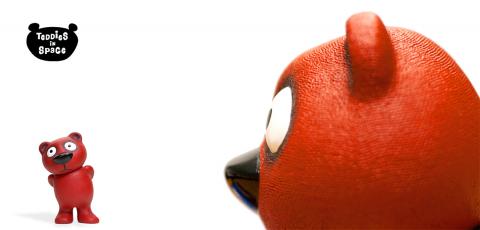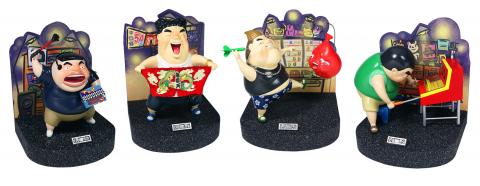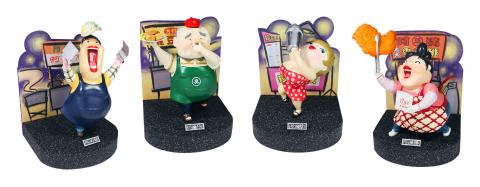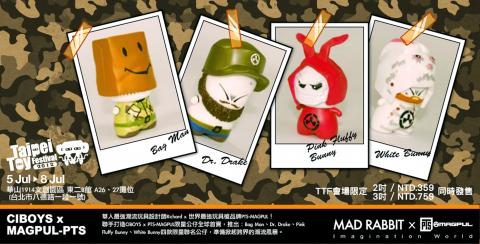The ninth annual Taipei Toy Festival (台北國際玩具創作大展) kicks off today at Huashan 1914 (華山1914). The event, which features more than 200 designers, runs through Sunday.
The show was originally designed to showcase an international array of designers, but the number of Taiwanese studios represented has steadily increased over the last few years. Half of the designers participating this year are from this country.
“At the beginning we had an international focus, but more Taiwanese toy designers are emerging,” says festival organizer Rita Shen (沈詩華). “We want to support Taiwanese designers, whether they are working individually or as part of a studio.”

Photo courtesy of Monster Taipei
Other countries represented include Hong Kong, Japan, Korea, France, Spain, Belgium and China.
Organizer Jen Huang (黃仁壽), director of toy distributor Monster Taipei (台北怪獸國際有限公司), started the festival in 2004. The event is now the largest convention in Asia dedicated to art toys (also known as designer toys or urban vinyl). It provides a platform for emerging designers to find distributors—and for toy fans to get their fix of limited edition figures, some of which will be sold exclusively at the Taipei Toy Festival.
The theme of this year’s festival is “designer toy wars” and the artwork for the event features two popular characters—Kennyswork’s Molly and Devilrobot’s Devid—engaged in a fight reminiscent of classic Japanese monster films. The theme captures the spirit of the festival: good-natured, friendly competition.

Photo courtesy of Monster Taipei
“They are good friends, but they are also like children,” says Shen of the two characters. “And children love to play-fight with their toys.”
This year’s festival will fill two buildings at Huashan 1914. One hall is dedicated to Hong Kong and Taiwanese designers, including the work of artist Po-wen (博文) whose lushly detailed fantasy illustrations have been translated into three-dimensional figures by sculptor PKKING. One goal of this year’s show is to highlight Taiwanese animators and comic artists, whose work is often overshadowed by Japanese imports. C.i.Boys, a line of toys which enjoys a devoted following of passionate collectors, will also have its own display space filled with a total of 1,000 figures, including limited edition and one-off designs. Some of the bigger brands include Kennyswork, Devilrobots and StayReal. As with previous festivals, limited edition toys created for the event will be available for the first 500 attendees each day.
Autograph sessions will feature team members from Devilrobots, Japanese designer Hiroshi Watanabe and Kenny Wong (王信明) of Kennyswork this afternoon. All of those designers will be available for signings again on Saturday, along with Po-wen. Sunday’s roster includes a live show and autograph session with 108 from Baaro Records.

Photo courtesy of Monster Taipei

Photo courtesy of Monster Taipei

Photo courtesy of Monster Taipei

May 11 to May 18 The original Taichung Railway Station was long thought to have been completely razed. Opening on May 15, 1905, the one-story wooden structure soon outgrew its purpose and was replaced in 1917 by a grandiose, Western-style station. During construction on the third-generation station in 2017, workers discovered the service pit for the original station’s locomotive depot. A year later, a small wooden building on site was determined by historians to be the first stationmaster’s office, built around 1908. With these findings, the Taichung Railway Station Cultural Park now boasts that it has

Wooden houses wedged between concrete, crumbling brick facades with roofs gaping to the sky, and tiled art deco buildings down narrow alleyways: Taichung Central District’s (中區) aging architecture reveals both the allure and reality of the old downtown. From Indigenous settlement to capital under Qing Dynasty rule through to Japanese colonization, Taichung’s Central District holds a long and layered history. The bygone beauty of its streets once earned it the nickname “Little Kyoto.” Since the late eighties, however, the shifting of economic and government centers westward signaled a gradual decline in the area’s evolving fortunes. With the regeneration of the once

The latest Formosa poll released at the end of last month shows confidence in President William Lai (賴清德) plunged 8.1 percent, while satisfaction with the Lai administration fared worse with a drop of 8.5 percent. Those lacking confidence in Lai jumped by 6 percent and dissatisfaction in his administration spiked up 6.7 percent. Confidence in Lai is still strong at 48.6 percent, compared to 43 percent lacking confidence — but this is his worst result overall since he took office. For the first time, dissatisfaction with his administration surpassed satisfaction, 47.3 to 47.1 percent. Though statistically a tie, for most

In February of this year the Taipei Times reported on the visit of Lienchiang County Commissioner Wang Chung-ming (王忠銘) of the Chinese Nationalist Party (KMT) and a delegation to a lantern festival in Fuzhou’s Mawei District in Fujian Province. “Today, Mawei and Matsu jointly marked the lantern festival,” Wang was quoted as saying, adding that both sides “being of one people,” is a cause for joy. Wang was passing around a common claim of officials of the People’s Republic of China (PRC) and the PRC’s allies and supporters in Taiwan — KMT and the Taiwan People’s Party — and elsewhere: Taiwan and